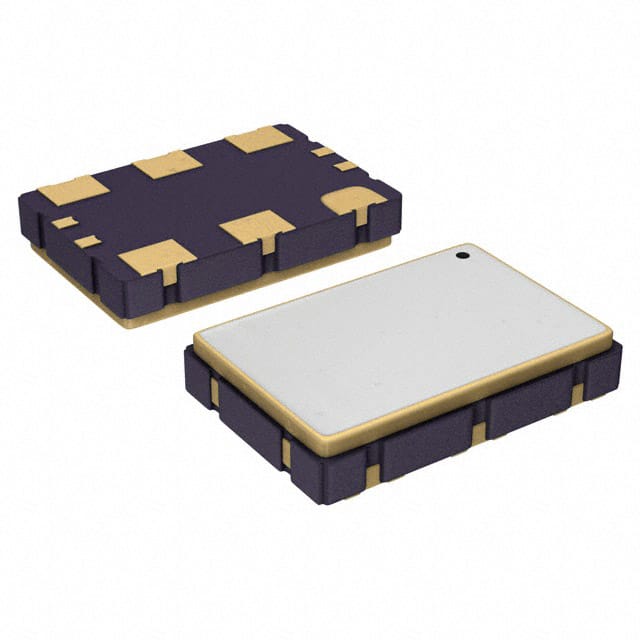Подробную информацию о продукте см. в характеристиках.

8N3QV01EG-0079CDI8
Basic Information Overview
- Category: Integrated Circuit (IC)
- Use: Timing and Frequency Control
- Characteristics: High precision, low power consumption
- Package: QFN (Quad Flat No-leads)
- Essence: Clock Generator
- Packaging/Quantity: Tape and Reel / 1000 units per reel
Specifications
- Supply Voltage: 1.8V to 3.3V
- Output Frequency Range: 1MHz to 200MHz
- Output Type: LVPECL (Low Voltage Positive Emitter-Coupled Logic)
- Operating Temperature Range: -40°C to +85°C
- Dimensions: 4mm x 4mm
Detailed Pin Configuration
The 8N3QV01EG-0079CDI8 IC has a total of 16 pins arranged in a specific configuration: 1. VDD: Power supply pin 2. GND: Ground pin 3. OE: Output enable pin 4. NC: No connection pin 5. OUT0: Output 0 pin 6. OUT1: Output 1 pin 7. OUT2: Output 2 pin 8. OUT3: Output 3 pin 9. FB: Feedback pin 10. SEL0: Select 0 pin 11. SEL1: Select 1 pin 12. SEL2: Select 2 pin 13. SEL3: Select 3 pin 14. SEL4: Select 4 pin 15. SEL5: Select 5 pin 16. SEL6: Select 6 pin
Functional Features
- Clock Generation: The 8N3QV01EG-0079CDI8 is designed to generate high-precision clock signals for various applications.
- Frequency Control: It allows precise control over the output frequency within a wide range.
- Low Power Consumption: The IC is optimized for low power consumption, making it suitable for battery-powered devices.
- Output Enable: The OE pin enables or disables the output signals, providing flexibility in system design.
Advantages and Disadvantages
Advantages: - High precision output frequency - Wide operating voltage range - Compact package size - Low power consumption
Disadvantages: - Limited number of output pins - Requires external components for specific applications
Working Principles
The 8N3QV01EG-0079CDI8 operates based on an internal oscillator that generates a reference frequency. This frequency is then divided and multiplied to achieve the desired output frequency. The feedback mechanism ensures stability and accuracy in the generated clock signal.
Detailed Application Field Plans
The 8N3QV01EG-0079CDI8 is commonly used in various electronic systems where precise timing and frequency control are crucial. Some application fields include: 1. Telecommunications: Clock synchronization in network equipment and communication systems. 2. Data Storage: Timing control in hard disk drives and solid-state drives. 3. Industrial Automation: Synchronization of sensors, actuators, and control systems. 4. Automotive Electronics: Clock generation for infotainment systems, navigation devices, and engine control units.
Detailed and Complete Alternative Models
- 8N3QV01EG-0066CDI8: Similar specifications with different pin configuration.
- 8N3QV01EG-0092CDI8: Higher frequency range with additional features.
- 8N3QV01EG-0045CDI8: Lower power consumption variant with reduced output options.
(Note: These alternative models are provided as examples and may not be an exhaustive list.)
This encyclopedia entry provides comprehensive information about the 8N3QV01EG-0079CDI8 IC, including its basic information, specifications, pin configuration, functional features, advantages and disadvantages, working principles, application field plans, and alternative models.
Перечислите 10 распространенных вопросов и ответов, связанных с применением 8N3QV01EG-0079CDI8 в технических решениях.
Sure! Here are 10 common questions and answers related to the application of 8N3QV01EG-0079CDI8 in technical solutions:
Question: What is the purpose of the 8N3QV01EG-0079CDI8 component?
Answer: The 8N3QV01EG-0079CDI8 is a specific electronic component used for various technical applications.Question: What are the key features of the 8N3QV01EG-0079CDI8?
Answer: Some key features of this component include high precision, low power consumption, compact size, and compatibility with different voltage levels.Question: In which technical solutions can the 8N3QV01EG-0079CDI8 be used?
Answer: This component can be used in a wide range of technical solutions such as power management systems, data communication devices, industrial automation, and consumer electronics.Question: How does the 8N3QV01EG-0079CDI8 contribute to power management systems?
Answer: The 8N3QV01EG-0079CDI8 helps regulate and control power supply voltages, ensuring stable and efficient operation of various components within the system.Question: Can the 8N3QV01EG-0079CDI8 be used in battery-powered devices?
Answer: Yes, this component is suitable for battery-powered devices due to its low power consumption and ability to operate at different voltage levels.Question: Is the 8N3QV01EG-0079CDI8 compatible with different communication protocols?
Answer: Yes, this component is designed to work with various communication protocols such as I2C, SPI, and UART, making it versatile for different applications.Question: What is the typical operating temperature range of the 8N3QV01EG-0079CDI8?
Answer: The 8N3QV01EG-0079CDI8 typically operates within a temperature range of -40°C to +85°C, making it suitable for both indoor and outdoor applications.Question: Can the 8N3QV01EG-0079CDI8 be used in high-frequency applications?
Answer: Yes, this component has a wide bandwidth and can handle high-frequency signals, making it suitable for applications that require fast data transmission.Question: Does the 8N3QV01EG-0079CDI8 require any external components for operation?
Answer: The 8N3QV01EG-0079CDI8 may require some external passive components such as capacitors or resistors, depending on the specific application requirements.Question: Where can I find more detailed information about the 8N3QV01EG-0079CDI8?
Answer: You can refer to the datasheet provided by the manufacturer or visit their official website for comprehensive technical specifications and application notes related to this component.
Please note that the answers provided here are general and may vary based on specific application requirements. It's always recommended to consult the datasheet or seek expert advice when using electronic components in technical solutions.

